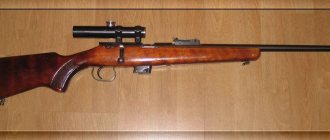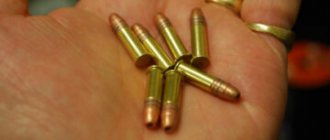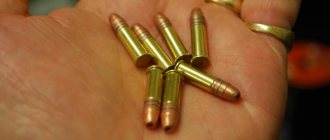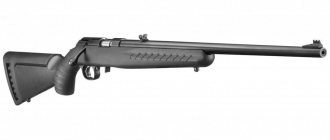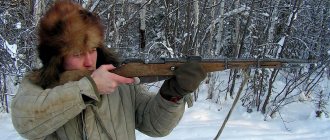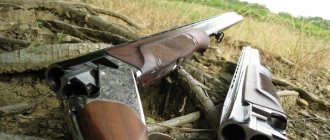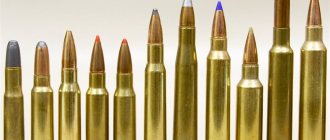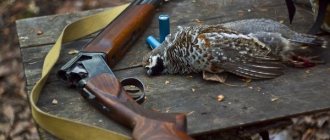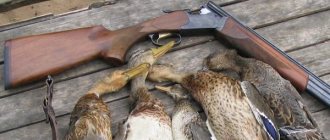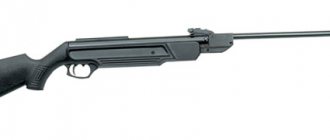- November 3, 2018
- Weapons and ammunition
- Natali Michaelis
Smallmouth cartridges have been used by hunters for many decades. This type of ammunition is especially valued among shooters who engage only in commercial hunting. Smallmouth cartridges are also successfully used by both novice hunters and more experienced professionals. In addition, they are used by special services in many countries around the world. So, let’s take a closer look at the characteristics of small-gun cartridges, as well as how to choose the right ammunition for beginners.
What is small caliber used for?
Small-caliber weapons can be called a good example of the fact that the main factor in shooting accuracy is not the weapon, but specifically the type of ammunition. After the development of .22 LR cartridges, the shot lengthened significantly, and the structural feature of such a side-ignited cartridge case allowed engineers to make more than 10 types of cartridges, for which special types of weapons were created in the future.
Types of 5.6 mm cartridges
With a wide variety, the most popular cartridges for small side-fire are considered to be .22 LR and .22 WMR cartridges. The first type was invented and first released more than 100 years ago. During all this time, cartridges for small guns, photos of which are presented in this article, have gained great popularity all over the world, breaking the record for the number of shots fired. The full name of such cartridges will be as follows: a 22-caliber cartridge, the bullet diameter of which is 5.6 mm, L - long, R - rifle, since it has a rim on the bottom of the cartridge case.
Since a small cartridge cartridge, the caliber of which is 5.6 mm, has a fairly low energy generated from the shot, and the flight trajectory of the cartridge case changes greatly, they are used for shooting at a short distance from the main target. In most cases, professional hunters use these cartridges when hunting small animals, such as birds or rodents.
In our country, the 5.6 mm smallmouth cartridge is used for hunting squirrels and sables. As for the United States of America, such ammunition is used to shoot gophers.
When considering the characteristics of small-arms cartridges, you should also pay attention to the fact that they can be used for various types of weapons: pistols, carbines, and machine guns.
The second popular cartridge of this caliber is 22wmr. Such cartridges are produced mainly for civilian use. This caliber is very popular in the United States of America. The cartridge was invented in 1959, when it was used to hunt very large animals, such as jackals or coyotes. The use of cartridges of this type for small animals does not make any sense, since the ammunition severely damages the animal’s body.
In addition, both types of small-sized cartridges are actively used during shooting training among beginners, since these ammunition are low in cost.
Bullets, good and not so good
Let's start with the fact that I will talk about 4.5mm bullets from manufacturers common in our country.
One of the most common manufacturers is the Spanish company Gamo. The company has been on our market for a long time, has a wide range of products, let’s go over the main representatives.
- Gamo Magnum.
To be honest, bullets are not a gift. They are packaged in metal jars of 250 pieces each, standard jars with a yellow stripe. Let's go through the parameters:
Weight - 0.49 grams or 7.56 grains.
Length - 7 mm.
Diameter - we thought 4.5, yeah, maybe not so 4.47mm
To be honest, the bullet does not have the best ballistic qualities, the main reason lies in the fact that the manufacturer churns out millions of them, but it’s a shame about the quality, I forgot about such a creature, on the sides of the bullet in unreal quantities there is such an unwanted guest as a flash, and with it came such relatives how varied in size, wrinkledness, and cousin weight, how would it be without it! Some bullets have to be pushed into the barrel with great effort, and some are sent into the barrel on one side and, waving goodbye to the shooter, fall out on the other.
But the bullets scatter like pies with meat and potatoes, and the point is that this ammunition is budget-friendly; in one store I bought a pack for only 150 rubles in banknotes from the Bank of Russia. Suitable for shooting from rifles with a power of up to 7.5 J inclusive, only the barrel gets dirty with them, clean them more often and it’s completely fine.
- Gamo Pro Match.
Bullets for “target shooting” with a blunt nose ha ha ha! God, what kind of clown came up with this, I don’t deny I could be wrong, but basically blunt-tipped bullets are designed for accurate shooting at paper targets. Characteristics at the highest:
Weight - 0.49 grams or 7.56 grains.
Length - 5.5 mm.
Diameter - 4.8 mm.
It is absolutely not suitable for target shooting - there is a strong spread, the same relatives came to this Spanish ballet, taking with them their uncle's variety of lengths, but due to the flat head, these "Spanish women" at least do not fall through the barrel and enter with mildly expressed resistance.
The bullets also work well for novice shooters; they are fired from rifles that are by no means magnum class - they are too light, the barrel is made to please a sweet soul, but not after 250 shots, but after 550-600 shots. One pack of these “ammunition” costs 300 rubles, but they are not worth even half of this amount.
- Gamo Round.
The lead ball fully justifies the saying, not for us and not for you. Let me explain, it is absolutely impossible to shoot them from rifles, they can sometimes fly into the barrel with a whistle, and when you do shoot, hmmm (one very biting, but very indecent word begs to be said) there is no accuracy, the penetration ability is reduced in one word not a bullet, but one name. It’s also unrealistic to shoot them from gas-cylinder pneumatics, since the gases are released into the gun’s magazine and the balls there turn into pancakes; copper-plated steel ones will survive this, but lead ones will not. As always characteristics:
Weight - oddly enough, but still 0.53 grams or 8.18 grains.
Length - well, it's a ball.
Diameter - 4.5 mm.
There are not a bunch of defects, but they are there, it’s not a ball, but rather a geoid - with edges flattened on both sides, scientists will rather create a micro-slingshot, ammunition for it, the Spaniards have already made these kind of grinders, and the matchmaker has different calibers and at this holiday he drank a couple of glasses, 20 bullets from a pack Still, they rolled out of the trunk.
However, 250 balls cost 200 rubles, sorry gentlemen, sellers, well, this is pure robbery, for such a holomnez to break such loot. Don’t think badly, I’m not talking about this site, I wasn’t looking for them here.
- Gamo Rocket.
An interesting thing, these are bullets with a core, or rather a steel ball is pressed into the head of the bullet, the diameter of this ball is 2-3 mm. With these bullets, the penetrating effect of the bullet really increases; steel is better than lead in this sense. There are also disadvantages in a pack of only 150 bullets, and the cost of this box sometimes goes beyond 300 rubles. Let's step on the tail of the characteristics:
Weight - 0.62 grams or 9.26 grains.
Length - 7.5 mm.
Diameter - 4.5 mm.
I can say that the quality of these bullets is very good, no nasty drunken relatives from the 3 previous banquets, except that one bullet from the pack was only half, and this is a good defect rate of 1 in 150. I advise everyone who doesn’t have a very powerful rifle but wants to buy it destroys, hits bottles well and makes through holes in 20 mm boards.
with Gamo for now. The general conclusion about all bullets of this brand is this: they are attractive at a low price, but at the same time there are complaints about the quality. (Believe me, our bullets are much worse).
Let's move on to overseas bullets. I think that the Crosman is known to all people who shoot air rifles wisely. These bullets are produced in the USA and under a Pindos license in China (well, where else). For now, we will describe one type of bullet from this manufacturer.
- Crosman Destroyer.
At the moment, the first hollow-point bullet I came across, this one even has a semblance of a ballistic tip. It is made of high-quality lead alloy, but it is a little hard for expansion, and at the same time it does not clog the barrel too much. The quality of workmanship is at the American level - good but not very good, seams are visible and palpable at the joints, Spanish relatives did not come to this holiday, but the matchmaker came, mixed party half a pack weighs 0.50 grams, and the rest 0.52 grams, but the difference is 2 hundredths seem like nothing, but the fact that it exists at all is infuriating. Specifications:
Weight - 0.51 grams or 7.88 grains.
Length - 6 mm.
Diameter - 4.5 mm.
The bullet has good expansive qualities despite the fact that it has a ballistic tip, it straightens out into the trash, I take the bullet out of a piece of plasticine, the skirt is wrapped up to the very back of the bullet’s head, and there is nothing left of the ballistic tip. For any expansions, the weak point is accuracy, although there is a semblance of ballistic tip. The accuracy is not so great, but it’s better than the same HandN Crow Magnum, I have nothing against these bullets, but they not only do not have a ballistic tip, but also its resemblance like the ones I’m describing now.
At the moment, on Crosman, I’ll describe a couple more bullets later
We are returning to Europe, our next manufacturer is the world famous Haendler and Natermann
This is an excellent German manufacturer that has rightfully earned its fame among pneumatic shooters. Excellent production quality, a large line of bullets of different calibers, as they say, for every taste, color, size and budget.
- Rabbit Magnum.
Very heavy and powerful bullets for super powerful pneumatics, unlike most bullets, these are not shaped like cups, Christmas trees and caps, but are shaped like firearm bullets, a cylinder with a pointed tip, but it is not sharp, but rather oval. The so-called ogival form. Bullet parameters:
Weight -
1.02 grams or 15.74 grains.
Length - 8 mm.
Diameter - 4.51 mm.
Gorgeous wunderwaffles, I have never seen anything better in my entire life, very, very, very heavy pneumatic bullets, if you shoot at the same crow with JSB and RM II , the difference is very large after the first hit, weighing 0.87 grams, the crow gets a through penetration and can fly further 50-100 meters and this is only a crow, after being hit the game must lie down and lie there until the shooter arrives. When using RM II the crow receives a severe, non-through wound and lies down to sleep forever and ever. What I can say in terms of quality is that it is at the height of no burrs, no flakes, no wrinkles, beauty and that’s all, but the cost mercilessly hits the wallet, but it’s worth it in a pack of only 200 pieces, but this is quite enough for running in ammunition. Weapon - any rifle that costs 25 J.
We continue our march through Europe, now we will go a little further south - to the Czech Republic. The Czechs do not sleep and do not drink Czech beer; they make excellent bullets under the JSB ; we will tell you about one bullet from this manufacturer.
- JSB Monster Exact.
“Czech beauty” is what I call these bullets. They fully live up to this name. The parameters just beg the reader:
Weight - 0.87 grams or 13.4 grains.
Length - 7 mm.
Diameter - 4.5 mm.
Excellent high-precision ammunition for magnum and super magnum class rifles, to put it simply, you can’t put this bullet in any barrel, the pneumatics on the cylinder are too weak for this, almost all domestic rifles are not suitable for firing these bullets, well, except perhaps the MP 512, but it must be incredibly strong . These bullets are by no means cheap, a pack of 400 bullets costs about 400 rubles, but for those who love their weapons and don’t want to ruin them, it’s not a waste of money, I know from myself. This bullet in general and all JSB love supersonic speeds and this must be taken into account when purchasing them, I’m not talking about people who buy a Rabbit Magnum II and put them in an MP 60, this means that, of course, you need to take into account the capabilities of your rifle.
Permission to shoot
As for obtaining permission to shoot from small-caliber weapons, it will be no different from obtaining permission to use a rifled barrel. To do this, the hunter must collect certain documents and then submit them to the LRO. To be more precise, the following documents are required:
- Certificate of passing a medical examination.
- Hunting license.
- A report that was drawn up by the local police officer, which contains information regarding the storage conditions of firearms.
It should also be remembered that a permit for a rifled weapon can only be obtained by a person who has at least 5 years of experience in handling smooth-bore guns.
Choosing a pneumatic bullet manufacturer
The question of which manufacturer of pneumatic bullets for hunting to give preference to is one of the most common in various weapons and hunting forums. The debate over the best company is fierce, but it would seem that the difference is small. Based on user reviews, as well as expert opinions, we have compiled two tops, dividing bullets into two categories - light and heavy. In the blocks below you will find not only the names of the ammunition with the price, but also their rating:
Light bullets
Light bullets are ammunition whose mass fluctuates around 1 gram (plus or minus 0.5 grams). Heavier options (1.5 grams and above) already belong to the next category of ammunition, so do not rush to be upset if your favorite cartridge is not in the top:
| Place | Name | Rating | Price and number of cartridges |
| 1 | Predator Metalmag | 9/9/10 | 869 rubles (200 pcs) |
| 2 | H&S Field Target Trophy Power | 9.7/10 | 415 rubles (200 pcs) |
| 3 | Crow Magnum | 9.6/10 | 590 rubles (200 pcs) |
| 3 | Gamo Magnum | 9.4/10 | 487 rubles (250 pcs) |
| 3 | H&N Hornet | 9.2/10 | 1290 rubles (200 pcs) |
1st place - Predator Metalmag
This Czech ammunition is considered one of the best (among light ones) for hunting.
The weight of each bullet is only 1.03 grams, which allows you to shoot this cartridge even at extremely long distances. Stamped ammunition consists of two parts: a lead shell, as well as a sharp brass tip - it is this design, combined with the choice of materials for manufacturing, that provides the bullets with ultra-light weight. It is also worth noting that Predator Metalmag is manufactured to strict JSB standards, so customers rarely complain about defects in the product. And all this at a very affordable price.
2nd place - H&S Field Target Trophy Power
This 5.5 mm caliber ballistic projectile can be called universal, since it is equally well suited for hunting as well as for training or recreational shooting. It's all about the rounded tip, which not only provides good ergonomics at long distances, but also penetrates perfectly into flesh, and also leaves fairly even holes on paper targets.
It is also worth noting that the bullet is coated with a layer of copper - this is done in order to increase the shelf life of the ammunition, as well as to give customers the opportunity to use it on smooth-bore weapons. The lightest bullets from our top.
3rd place - Crow Magnum
Well, this cartridge is known to almost every hunter, since it was with this cartridge that professionals at shooting ranges began to train. In addition, this ballistic projectile is somewhat similar to an expansive projectile, since it has an unusually shaped tip. The well-known German company H&N is engaged in the production of such bullets, so there is no doubt about the quality of the product. Well, considering that the weight of the ammunition is only 1.18 grams, finding a use for it will not be difficult. Also, many experts say that these bullets have one of the best balances - the trajectory displacement vector at the moment of departure from the barrel is close to zero.
4th place - Gamo Magnum
Well-known Spanish rolled ammunition, which is not distinguished by anything special, but is very popular due to its low cost. Remember the plastic-wrapped Christmas tree balloons that were popular before the 2000s? So this is practically the same cartridge, but sharpened for a caliber of 5.5 millimeters. And given the fact that the ballistic projectile consists entirely of lead, it has a fairly low mass - only 1 gram.
The bullets are great for beginners due to their low cost, as well as their versatility - they can be used for both target shooting and game hunting.
5th place - H&N Hornet
Another cartridge from the already mentioned arms company. This ammunition is very reminiscent of the “Predator”, since it has structural similarities, as well as a slight difference in weight (the weight of the bullet is 1.05 grams). However, due to its high cost, the cartridge is only in 5th place. However, there are still differences from the Czech cartridge. And the main one is a more pointed tip, which increases the penetrating power of the bullet. In addition, many experts note that German cartridges have a much less negative impact on the rifled barrel. So if you care about the “health” of your rifle, don’t be afraid to overpay.
It is worth noting that these are only those lightweight cartridges that are most popular among hunters. As for the various Terminators and Barracudas, everyone knows that these ammunitions are also quite good, but they still do not reach the mentioned five in terms of quality and technical characteristics. However, if you don't see anything wrong with saving on ammunition, then you can look at other bullets. We will now focus our attention on heavier cartridges - expansion bullets.
Expansive bullets
It would be quite boring to review in the second section only those bullets that are distinguished by high mass. A better idea is to look at different types of expansive (explosive) bullets, which also weigh more than 1.5 grams in most cases. Such cartridges are not suitable for shooting at long distances (over 100 meters), but when they hit the flesh they expand, which in most cases is fatal. Here are just the most interesting of such ammunition:
| Place | Name | Rating | Price and number of cartridges |
| 1 | Hollow Point | 9/8/10 | 353 rubles (200 pcs) |
| 2 | KSPP "Expansivnaya" | 9.5/10 | 1240 rubles (250 pcs) |
| 3 | Baracuda Hunter Extreme | 9.3/10 | 760 rubles (200 pcs) |
| 3 | Gamo Expander | 9.2/10 | 465 rubles (250 pcs) |
| 3 | Baracuda Hunter Classic | 9.0/10 | 569 rubles (200 pcs) |
1st place - Hollow Point
This German expansion cartridge is one of the most famous in the whole world. The bullet consists entirely of lead, so it does not weigh the most - 1.82 grams. However, using the cartridge for long-range shooting is not the best idea since it has a negative balance and also loses its height over time. However, the most notable feature of the cartridge is its low cost and high quality - perhaps the best example of how to make a high-quality and inexpensive expansive projectile. By the way, this cartridge has been produced since 1990, so we can say that it has really stood the test of time.
2nd place - KSPZ "Expansivnaya"
The best Russian expansion cartridge, which may well compete with foreign analogues. This bullet is distinguished not only by its fairly large weight - 2.58 grams, but also by its unusual shape. Almost half of the bullet is the tip, which opens up when it hits the target in the shape of a “rose,” leaving the animal no chance of survival. However, due to its high weight, the cartridge is not suitable for every rifle.
It is best to choose it for the “supermagnum” class so that the weapon can push out a bullet with a sufficiently large shape. Otherwise, the target range will be no more than 75 meters.
3rd place - Baracuda Hunter Extreme
Perhaps the most powerful expansive projectile in terms of how much the bullet tip expands after hitting the target. That is why it is loved by many professional hunters who shoot predatory animals with air guns. However, the Barracuda has a well-known drawback - not a very good balance. Even during training shooting, the spread of bullets at a distance of 50 meters is 2-3 centimeters, which is incredibly high for a hunting cartridge. However, if we assume that the shots will be fired from a shorter distance, and even from a powerful weapon of at least the magnum class, then even an adult wolf will have no chance.
4th place - Gamo Expander
Many people claim that the burst cartridges from the Spanish arms company are the best in the whole world. The reason for this lies in the high accuracy of the ammunition. The bullet weight is only 0.5 grams, which is unusual for an expansive 5.5 mm bullet. Thanks to this, the bullets can be used for long-range shooting using an optical sight. However, everything would be fine if not for the low penetration ability of the cartridge.
Low weight does not have the best effect on penetrating ability, so this cartridge is suitable for hunting only small fur-bearing animals or game birds.
5th place - Baracuda Hunter Classic
Another “Barracuda” in our top, however, unlike the previous variety, this projectile has a classic head for an expansive bullet - a regular recess. Not the best bursting ability, but the cartridge retains its accuracy of fire much better (dispersion of no more than 1 centimeter when shooting from 50 meters). Perhaps it is precisely because of this feature that many hunters give preference to this ammunition instead of buying “Extreme”. As for other points, they are practically no different from classic German expansion cartridges - the best quality in the world and high reliability.
Disadvantages and advantages of small things
We have looked at which cartridges are best for small guns. Now it’s worth familiarizing yourself with the main advantages of using such cartridges. The main advantages are as follows:
- A small hole in the body of the victim after the shot, which preserves the integrity of the skin.
- Minor recoil during firing.
- Slight noise when fired.
- Possibility of using a muffler.
Low cost, as well as availability of cartridges for small 5.6 mm rifles. Thanks to this, hunters can hone their own shooting skills.
You should also pay attention to the fact that the best cartridges for small guns also have some disadvantages. They are as follows:
- The ability to hit only a nearby target.
- Insignificant killing power.
Features of 5.6 mm cartridges
We continue to consider which cartridges are better for small guns. The 5.6 mm .22 LR caliber cartridge got its name due to the fact that the bullet diameter is 22 inches, which is equal to 5.6 mm. This type of ammunition does not have a primer. When a shot occurs, the firing pin hits the side area of the bottom of the cartridge case, which is why it is commonly called a side-fire cartridge.
For a small cartridge, the size of which is 5.6 mm, the impact composition is pressed into the rim of the sleeve. When the hunter pulls the trigger, the firing mechanism of the weapon removes the rim, and the primer composition begins to ignite. As a result, the main powder charge begins to ignite.
If you don’t know which cartridges are best for small guns, then you should give preference to ammunition with a diameter of 5.6 mm. Thanks to the special design, the rim of this cartridge can be easily removed from the impact of the striker. You should also pay attention to the fact that the walls of the case must be thin, thereby limiting the maximum pressure that is created due to the ignition of the gunpowder. If the charge in the cartridge is too powerful, the cartridge case may completely rupture during firing.
How to choose the right bullets for pneumatics
Despite the fact that we have listed the 10 best bullets in our top, according to experts and hunters, and also divided them into two categories, many readers may still have a question about which bullets for pneumatics to choose. To decide this, try to answer the following questions for yourself:
- For what purposes do I need a 5.5 caliber bullet? Of course, most people take such cartridges for hunting game, but do not forget that the animals in the forest are different. For some, an ordinary light Christmas tree bullet will be enough, while others are unlikely to die even after being hit by an expansive Barracuda. So be sure to take into account the size of the potential prey and the penetrating ability of the cartridge - this will help you avoid unpleasant situations while hunting.
- What cartridge fits my rifle? Unfortunately, the fact that a particular weapon uses 5.5-caliber cartridges does not mean that any existing ammunition of that diameter can be inserted into the weapon. Some heavy bullets are being developed only for supermagnum class rifles. Others are best suited for weapons that are not very powerful, so be sure to check this with your sales consultant.
- Will I use the bullets for anything other than hunting? Not all people buy a 5.5 caliber rifle just to hunt wild animals. Some also like to occasionally shoot at targets or cans, feeling real power in their hands. If you are one of these people, then buy universal cartridges with a rounded tip. This bullet performs equally well in hunting and training.
- At what distance do I plan to shoot? As mentioned earlier, each ballistic projectile has its own ergonomic properties - the ability to overcome air resistance. If you need a bullet for sniper shooting, you will have to give up the expansion and choose something with a rounded tip. If shooting is mainly carried out from 30-40 meters, then there is no point in sacrificing power.
- How important is gun health to me? Many cartridges come with a copper jacket, which prevents the bullet from negatively impacting the barrel when fired. Copper is much softer than steel, so it does not leave scratches even on rifled weapons. However, such cartridges are slightly more expensive than classic ones for obvious reasons. Therefore, be sure to consider whether you are willing to pay extra to make the rifle last longer.
And, of course, we shouldn’t forget about the price issue, which is far from the last priority for the Russian hunter. The cost of modern ammunition can vary quite a lot, so it is worth choosing those bullets that can be purchased regularly. Otherwise, you will have to use different cartridges all the time: in the best times, the hunter buys expensive KSPPs, in the worst times, he is content with the budget Hollow Point. This should not happen, otherwise it will not be possible to achieve high accuracy.
Characteristics of cartridges
- The caliber of the .22 LR cartridge is 5.66 mm.
- The mass of the bullet can be from 1.9 to 2.6 g.
- The maximum weight of gunpowder reaches 0.34 g.
- The initial speed of the ammunition is from 325 to 345 meters per second.
- When the bullet is at 50 m from the muzzle of the weapon, its speed is 295 m/s.
- As for the initial energy of the ammunition, it is equal to 135 J.
- After a bullet flies 50 m, the energy is 110 J.
- The length of the cartridge reaches 2.5 cm. The length of the sleeve is 1.5 cm. In the upper part the diameter is 5.75 mm, and in the lower part it is 7.1 mm.
A little history
The small-caliber cartridge, which has a diameter of 0.22 inches, was first invented in the late 19th century by Stevens Arm and Tool Comp. Then it was equipped with a bullet whose weight was 2.6 g. The total weight of gunpowder in it was 0.32 g. However, in those days it was impossible to measure the speed of the bullet. Modern samples of ammunition from this company have remained virtually unchanged. The sleeve is made of metal, the length of the cartridge is 25.5 mm. The main differences between modern cartridges and the 1887 models are that lead ammunition is now entangled in a special casing to improve ballistic characteristics.
When compared with the first developments, modern bullets used by hunters have a mass of 2.6 g. When firing from a weapon with a long barrel of 152 mm, the maximum speed of the cartridge case after the shot will be 345 m/s, and the muzzle energy will be 140 J. When firing from a rifle with the longest barrel, the speed of the bullet increases by about 60 m/s.
There are currently four rimfire cartridges in production:
- The most powerful cartridge is called Hyper-velocity. When fired, the bullet reaches speeds of up to 425 m/s.
- The next most powerful cartridge is called High-velocity. Its maximum speed is 400 m/s.
- A side-fire cartridge with a standard bullet velocity is commonly called Standard-velocit.” Its speed is 343 m/s.
- Small-caliber cartridges with a bullet sound speed that reaches 335 m/s are called Subsonic.
It should be noted that the ejection speed of cartridges will be influenced by many different factors, for example, barrel length, ammunition manufacturer, and much more.
Which bullets are better
The choice of ammunition from a particular manufacturer and its type depends on the technical capabilities of the weapon and the area of use. We must not forget that bullets of different shapes with the same mass and fired at the same speed differ in ballistics and kinetic energy in all parts of their flight.
It is the ballistics of a bullet that shows its aerodynamics:
- wind resistance;
- flatness;
- power losses in sections of the trajectory.
To study these characteristics of any ammunition, the ballistic coefficient is applied. Knowing this parameter, the weight and speed of departure, you can accurately calculate the trajectory and enter the required correction into the optics in order to hit the target even at this distance:
- Ammunition for pneumatics with a caliber of 4.5 mm is lightweight. Sometimes it may seem that this bullet weighs practically nothing, that is, it makes no difference which bullet you choose. But this is completely wrong. The mass of the cartridge is radically different - from 0.25 to 1.2 grams, and has different areas of use.
- The mass of the cartridge must correspond to the power of the gun. At 7.5 J it should not be more than 0.50 g. At 16 J - 0.60 g. If the weapon is even more powerful, you need to use the heaviest ammunition.
- Light cartridges (up to 0.45 grams) are used on low-power weapons. Gas pistols and light rifles must be equipped with precisely this ammunition.
- Medium (0.45-0.55 grams) bullets are excellent for pneumatics with a power of over 17 Joules. Often these cartridges are used for more powerful guns (25-28 Joules).
- The use of heavy (more than 0.55 grams) cartridges implies the transfer of maximum energy to the bullet. Ammunition is used for hunting.
Cost and quality vary depending on the manufacturer. The basic rule is experience and individual choice.
Domestic cartridges
Since the 5.6 mm caliber cartridge is quite often used in hunting and sports shooting, domestic manufacturers are also involved in its production. Russian-made small-caliber rifle ammunition has different names: “Marmot”, “Temp”, “Sobol”, “Extra”, “Olympus”, “Junior”.
In addition, for those who like to shoot at the shooting range, cartridges with a diameter of 4.5 mm are manufactured. They are made from lead. This design does not provide a powder charge, so such cartridges do not need a casing. Cartridges for small guns with a diameter of 4.5 mm are activated when fired due to the powerful impact of the firing pin on the rear area of the ammunition.
Types and types of bullets for pneumatics
Pneumatic bullets with a caliber of 4.5 mm differ in shape and main purpose:
- Lead balls (Round). Used for recreational shooting. Can be used for multi-charge pneumatic models. They have high penetration ability and receive a rotational movement while passing through the barrel. They have good accuracy and a large mass - approximately 0.55 g.
- Copper-plated steel balls (BB). They are used for entertainment, have an average accuracy - about 4-6 cm from a distance of 10 m. They are used, as a rule, in multi-shot pneumatics (magazine or hopper), since they do not require orientation during feeding. The mass of the bullet is approximately 0.31-0.34 g. The caliber is in the range of 4.34-4.43 mm. Accuracy is worse, unlike lead balls, especially at significant distances. In the process of hitting the target, due to the lack of deformation, the bullet produces a more “powerful” effect, but is more prone to ricochet. It is not recommended to use it for pneumatics with a rifled barrel, this leads to rapid wear.
- Lead bullets with a hemispherical head (Domed). This is a universal form that is used for hunting and sport shooting. They are characterized by good accuracy while maintaining maximum energy over significant distances due to high aerodynamic performance. They have high penetration ability.
- Lead bullets with flat head (Match). They are used for sports and training shooting at targets from a distance of up to 10 m. At short distances they can have a shock effect on small animals. When the bullet hits a paper target, it punches a clear, round hole. Due to high resistance and lack of aerodynamic properties due to the peculiarities of the manufacturing form, they have relatively low accuracy at distances that exceed 15 m. Moreover, at speeds above 180-220 meters per second. But at low speeds, due to the stabilization of the oncoming air flow, they help achieve good accuracy at distances of up to 10 m. Most often they are made with a mass of 0.45-0.6 g and have high quality workmanship.
- Lead bullets in the form of a cylinder (with various heads). Used for entertainment and plinking. The parameters are similar to Diabolo bullets. Their creation was facilitated by the need to increase the mass of the 4.5 mm bullet. Moreover, they have an elongated shape, and the middle part has a cylindrical appearance.
- Pointed bullets. Used for hunting and entertainment. They are distinguished by high penetrating ability. Aerodynamics are average. There is a myth that conical bullets are better than hemispherical bullets, this is a wrong judgment: any deviation of the front part from its axis will lead to a decrease in accuracy. During a tangential hit, this bullet slides to the side and its shock effect is also worse.
- Explosive bullets. They are made of plastic, with a core of various materials. They are used for visual and noise determination of the target impact location. Explosive bullets are used for entertainment and shooting purposes. The cartridge contains a detonating substance, usually Berthollet salt. Contact with the target upon impact is accompanied by a loud sound and sparks.
- Lead bullets with a steel core. Lead, with a core of some material (steel). Used for entertainment. The steel core protrudes a couple of millimeters, and thanks to the hard metal it has high penetration properties. When hitting the target, the lead sheath remains outside, and the core passes into the target. They have low accuracy, but good destructive abilities.
- Cap-shaped bullets. They are used for entertainment over short distances (the lightest) and are the raw material for the manufacture of homemade cartridges for various purposes (pyrotechnic, expansive). The shape resembles a hollow bowl with a bottom in the form of a cone or dome. The mass of the bullet varies between 0.25-0.35 g. The target flight range is no more than 15 m. They are often used in shooting ranges for shooting weapons up to 3 Joules.
- Arrows and darts. A sub-caliber needle, which has a plastic stabilizer or a tail in the shape of a soft brush. Used for shooting at special targets and entertainment. Caliber - 4.40 mm, size - 2.40-3.10 cm. Due to the large length of the arrows, they are used only in single-shot pneumatics and certain revolvers that have a full-size drum. During flight, the arrow tip makes circular rotations - precession, so the shooting accuracy and target range are low. They are practically not used for hunting purposes. Their cost is an order of magnitude more expensive, unlike other types of bullets, and they greatly damage the barrel channel. Plastic or fabric tails collect a lot of dust and dirt, and in the process of moving along the barrel, all this has an abrasive effect, so the rifling is quickly erased, and an expansion is created at the end of the barrel like a funnel.
- Lead expansion bullets (Expander). Used for hunting purposes and to get rid of rodents. They are characterized by a strong shock effect, since the bullet head “opens” when it hits the animal. Moreover, this effect occurs only at high speeds.
Sports varieties
At international competitions, general rules require that all athletes have exactly the same conditions. Cartridges and weapons must comply with accepted standards. The use of .22 LR cartridges in sports can be explained by its low noise level, good penetration ability at a very short distance, low power, low recoil, as well as high reliability and accuracy. In addition, they are one of the cheapest options with a powder charge.
When shooting at a distance of about 25 m, the sight ratio should rise by about 2 cm. If the distance increases to 75 m from the target, then the bullet will drop from the aiming point by about 7 cm. If the distance is 100 m from the target, then the bullet will deflect approximately 25 cm down.
The cartridges that are used by athletes in various competitions have an all-metal bullet, which is made of lead. The mass of this ammunition is about 2.5 g. The initial speed of the bullet, which is measured from the muzzle of the barrel, is 330 m/s. Under this condition, the speed of a bullet made of lead, thanks to the rifling in the barrel, begins to stabilize. The best results in terms of accuracy can be achieved if you shoot indoors at room temperature, as well as in conditions of normal air humidity.
Choosing the best bullets for hunting
Before purchasing air rifle cartridges, there are many factors to consider in order to achieve good shooting results. There are many different types of bullets in gun stores today, but not all will work equally well.
Light bullets
| Place | Name | Rating | price, rub. |
| 1 | BB Gletcher shot (500 pcs.) | 8.2/10 | 380 |
| 2 | Luman Pioner bullets 0.3 g (550 pcs.) | 8.5/10 | 155 |
| 3 | Alpha bullets caliber 4.5 mm | 9.1/10 | 195 |
1st place – BB Gletcher shot (500 pcs.)
This is a shot made of steel for shooting from smoothbore revolvers and pistols with a caliber of 4.5 mm. The ball has a smooth surface and relatively stable characteristics in size, weight and material of manufacture. Bullets are compatible with models of any Russian and foreign manufacturers. Perfectly suited for pneumatics manufactured by Gletcher. They are located in a plastic bottle with a dispenser - for conveniently equipping the clip. Reuse of fractions is prohibited.
2nd place – Luman Pioner bullets 0.30 g
These are lightweight pneumatic bullets that have a smooth, round-headed surface. Stamped cartridges with good accuracy and accuracy. Far exceeds the workmanship of other cap cartridges in its class. They are used for entertainment and have an aiming range of up to 12 m. These ammunition are used for low-power air rifles.
3rd place – Alpha bullets
They have an almost flat head, only with a slight curvature. The shape and weight are observed quite accurately, the spread is reduced to a minimum. They are characterized by enhanced sealing of the head and high stability of the shank. This allows you to increase the initial flight speed and ensure high accuracy. There are 300 pieces in a jar, average weight is 0.50 g.
Due to the flat shape of the head in the paper target, clear round holes are obtained, this helps to accurately calculate the result and the number of points after shooting.
The cartridges are unique in their structure, this distinguishes them from other popular bullets of this type: a thin head obturation belt fits into the rifling of the barrel channel, and a thin-walled shank skirt reduces friction and increases stabilization as the bullet moves in the barrel. This structure gives the cartridge a high initial acceleration and improves accuracy.
Expansive bullets
| Place | Name | Rating | price, rub. |
| 1 | Crosman Premier Destroyer | 8.2/10 | 510 |
| 2 | H&N Terminator | 8.5/10 | 840 |
| 3 | H&N Baracuda Hunter Extreme | 9.7/10 | 940 |
1st place – Crosman Premier Destroyer
Bullets are used for entertainment and sports training shooting from pneumatics in the open air and in shooting ranges. The cartridges are stamped, have a sharp head without a seal protrusion on the shank. Due to this shape with a concave rim, the bullet can effectively maintain speed during flight, and also “bites” into the target almost completely, preventing the possibility of ricochet. There are 500 pcs in a box.
2nd place – H&N Terminator
They are of medium weight and accurate when shooting at medium distances. Increased penetration, excellent expansion with good sealing. Predictable deformation. Conical surface with smooth head. There are 400 pcs in a pack.
3rd place – H&N Baracuda Hunter Extreme
Heavy, highly accurate cartridges for long-range hunting. Deep recess in the form of a cross on the front to transfer kinetic energy and shock action. High accuracy due to the best aerodynamic performance. They have a smooth surface. There are 400 pcs in a pack.
Sports and hunting ammunition
These small bore cartridges have similar characteristics to those used for sporting events. But the former are inferior in quality, since manufacturers reduce the price of these products in order to increase demand. For those shooters who are just learning to shoot from rifled firearms, it is important that the ammunition is of very high quality, but the main condition is that it is cheap. To learn how to shoot most accurately, as well as quickly aim, you should hone your own skills and abilities over the course of several months. As a rule, 2 types of bullets are made for hunters: with a hole located in the head, as well as all-metal bullets.
JSB Exact Jumbo Diabolo .22
The shells are considered a simplified version of the classic JSB Diabolo Exact Jumbo Heavy. However, they have proven themselves well, including in spring-piston rifles.
The bullets weigh a little more than a gram, their ballistics are slightly less than those of Diabolo, and the price is a quarter lower. During testing, the shells showed a reduced level of quality when compared with other models of the Czech manufacturer. The diameter of their head part does not correspond to the official one. Perhaps you received a defective batch. However, such punctures from a serious manufacturer make you doubt the product.
TOZ shotguns
Currently, Russian hunters are provided with a large assortment of small-caliber types of weapons. The most popular brand among Russian professional shooters is considered to be a rifle belonging to the TOZ family.
The first such rifle was made by a Soviet designer who lived in the city of Tula. This happened in 1932. This weapon became famous due to its simple design, reliability and reliability. This rifle was widely used for training among novice shooters. The main purpose was to hunt small animals. Since the rifle had very good accuracy, the weapon became one of the favorites among hunters and professional athletes. On the modern weapons market there are many different modifications of the TOZ brand chambered for small-caliber cartridges:
- TOZ-16. This modern rifle occupies a leading position in terms of sales in Russia.
- TOZ-17. This is a modern modification of the outdated version of TOZ-8.
- Carbine "Sable". This example of a firearm was created on the basis of a rifle called “Biathlon”. This carbine is equipped with two types of magazines, the capacity of which is 5 and 10 rounds. It is also possible to install an optical sight on it.
- TOZ-78. A very silent, accurate weapon.
- TOZ-78-04M. This is a modified model of the previous model of the TOZ-78 rifle.
- TOZ-78-01M. This model is another modification of the TOZ-78 weapon. The main difference is the ability to install additional equipment for quieter and more accurate shooting.
In conclusion, it is worth noting that the .22 LR cartridge was used for sport shooting. Shotguns were used both single-shot and multi-shot. In some disciplines, different modifications of weapons could be used in competitions, while in others, athletes had to use only factory versions. Thanks to the relatively low energy of the cartridges after firing, competitions and training can be held in simple shooting ranges. Therefore, it is not at all necessary to rent a separate room or shooting range for small-caliber bullets.
Characteristics of pneumatic bullets
The length of the bullet of the most common caliber 4.5 mm most often ranges from 4.9-9.6 mm. This indicator sometimes plays a decisive role in multi-shot rifles (for example, with a drum-type magazine).
Air gun ammunition is made from steel or lead. The latter are used for rifled rifles, steel ones - for smooth-bore ones.
Taking into account the shape for smooth-bore weapons, bullets are divided into:
- arrows and darts;
- lead or copper-plated balls (BB).
For rifled weapons:
- cap-shaped;
- “Diablo” bullets (all varieties in the form of a coil or valances, with a different number of rifling on the belt) and their derivatives;
- lead balls.
The most popular are bullets for rifled pneumatics with a diameter of 4.5 mm. The main advantage of lead bullets is that they acquire a stabilizing rotation during flight when they pass through the rifled barrel channel, this significantly increases the accuracy of the shot.
As a rule, the caliber of ammunition varies around 4.47-4.53 mm, weight - 0.25-1.2 g.
Among the large number of cartridges, Diablo bullets should be especially highlighted; they have the best combination of penetration and ballistic characteristics. In shape, these ammunition are 2 truncated cones, which are located towards each other. Due to this, it was possible to reduce the friction of the bullet on the inside of the walls of the barrel channel, and, accordingly, reduce energy losses at the stage of passage of the barrel.
Proper balancing of the weight of the tail and head allows the bullet to have excellent flight stability. The shank, again due to the shape of the cones, increases in size under the influence of air under pressure and thus better closes the muzzle channel during takeoff, reducing air leaks.
The shape of the bullet head is:
- with a pointed head, usually conical (pointed);
- with flat headband (match);
- with a head of complex shape, for example, expansive with a recess (hollow point);
- with a rounded head (domed).
Moreover, the shape of the bullet, more precisely the part located behind the belt of the maximum caliber head, does not really matter - it is still located in the “shadow” of the head during flight and is weakly enveloped by air. Much more important in terms of aerodynamics is the weight distribution of the cartridge, the location of its main center of gravity. For any bullet shape and, to a lesser extent, weight, the weight distribution is different.
Taking into account the manufacture of ammunition, they are divided into:
- rolled (made using transverse rolling);
- stamped (bullets of the same size, of course, if a high-quality stamp is used);
- cast (cartridges for small calibers are not cast; for diameters of 4.5 and 5.5 mm this is impractical, and the quality is not very high, and the machines have a complex design and are quite expensive).
The quality of pneumatic bullets must be high - any deviation in weight or shape will inevitably lead to a deterioration in accuracy, and, accordingly, the possibility of a miss greatly increases. Typically, a change in bullet mass in the region of ±0.006 g in one production batch is a sign of high-quality ammunition.
If we consider the production technology, it must be said that rolling achieves better performance and, as a result, a cheaper cost of bullets, but the quality of production, even with high-tech equipment, is average. At the same time, stamping, despite its more complex manufacturability, makes it possible to produce high-quality products. It is easy to distinguish this type of bullet: rolled cartridges are distinguished by longitudinal stripes on the skirt, stamped bullets are smooth.
Separately, it must be said that the quality of the shot is also influenced by the possibility of retaining the energy of the cartridge after passing through the barrel of the gun. The energy of a bullet when fired depends on many aspects: weight, obturation in the barrel, which is determined by the width and size of the belts, the hardness of the metal during manufacturing, the shape and diameter of the cavity in the skirt.

